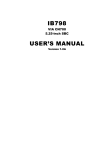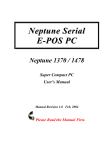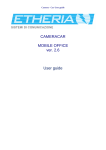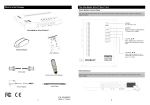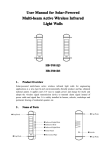Download ST268 USER`S MANUAL
Transcript
ST268 CLE266 Embedded Board USER’S MANUAL Version 1.1 Acknowledgments Award is a registered trademark of Award Software International, Inc. PS/2 is a trademark of International Business Machines Corporation. Microsoft Windows is a registered trademark of Microsoft Corporation. Winbond is a registered trademark of Winbond Electronics Corporation. All other product names or trademarks are properties of their respective owners. ii ST268 User’s Manual Table of Contents Introduction .......................................................1 Product Description............................................................. 1 Specifications ...................................................................... 2 Board Dimensions ............................................................... 3 Installations .......................................................4 Installing the Memory (DDR DIMM)................................. 5 Setting the Jumpers ............................................................. 6 Connectors on ST268 ........................................................ 10 BIOS Setup .......................................................21 Appendix ...........................................................44 A. I/O Port Address Map................................................... 44 B. Interrupt Request Lines (IRQ) ...................................... 45 C. Panel Type Selection .................................................... 46 ST268 User’s Manual iii This page is intentionally left blank. iv ST268 User’s Manual INTRODUCTION Introduction Product Description ST268 is a high-performance flexible embedded board based on the VIA CLE 266 chipset. The chipset is based on an innovative and scaleable architecture with proven reliability. It is a two-chip set consisting of the VT8623 North Bridge Controller and VT8235 South Bridge Controller. ST268 supports the Socket 370 processors with speeds of up to 1.4GHz and with front side bus of up to 133MHz. Two 184-pin DDR DIMM sockets supports can accommodate a total memory size of 1GB. Combining a fully integrated video processing feature set, Integrated UniChrome™ 2D/3D graphics engine and ultra efficient VIA DDR memory controller, the VIA Unichrome™ CLE266 Chipset is designed to enable high quality digital video streaming and DVD playback in a new generation of small form factor PCs and IA devices One 10/100mbps Ethernet is supported by the Realtek 8100C single chip Ethernet controller. With a secondary LPC I/O chip, the board supports six RS232 COM ports. With dimensions of 270mm by 160mm, ST268 has other features and connectors such CF card socket, two IDE channels, and four USB .1/2.0 compliant ports. ST268 User’s Manual 1 INTRODUCTION Specifications Product Name CPU Type CPU Voltage System Speed CPU External Clock Green / APM CPU Socket Chipset BIOS Cache Memory VGA LCD Interface LAN Sound LPC I/O Secondary LPC I/O Uart/16550A(6 ports) RTC/CMOS Battery Keyboard/Mouse Parallel IDE (44 pin) CF card connector USB Operating Temperature Storage Temperature Relative Humidity Dimensions 2 ST268 Socket 370 (Intel PIII / Celeron) 1.1V~1.8+5V 533MHz~1.4GHz 66/100/133Mhz APM1.2 Socket 370 VIA CLE266 North Bridge: 548 pin BGAVT8623 (2D/3D) South Bridge: 487 pin VT8235 Award BIOS, 2Mbit, supports ACPI function CPU integrated Two 184-pin DDR DIMM socket, DDR200/266 DIMM modules, Max.1GB VT8623 integrated AGP 4X VGA controller Support 18 bit LVDS panel (DF13-20) Realtek RTL8100C (10/100Mb) single chip Ethernet controller. AC97 Winbond 83697HF: Parallel x1, COM1, COM2, FDC 1.44MB (slim type), hardware monitor (3 thermal inputs, 8 voltage monitor inputs Fintek F81216D COM3, 4, 5, 6 (RS232) COM1, 2, 3, 4, 5, 6: RS232 Built in VT8235 Lithium Battery Built in VT8235 Built in VT8235, IDE1, IDE2 (UDMA 33/66/100/ 133) One port (share IDE2 slave) 4 ports, USB 1.1/2.0, (D-Sub x2, Pin header x2) 0°C ~ 60°C (32°F ~140°F) -20°C ~ 80°C (68°F ~176°F) 10% ~ 90% (non-condensing) 270mm x 160mm ST268 User’s Manual INTRODUCTION Board Dimensions ST268 User’s Manual 3 INSTALLATIONS Installations This section provides information on how to use the jumpers and connectors on the ST268 in order to set up a workable system. The topics covered are: Installing the Memory (DDR DIMM)...........................................5 Setting the Jumpers .......................................................................6 Connectors on ST268..................................................................10 4 ST268 User’s Manual INSTALLATIONS Installing the Memory (DDR DIMM) The ST268 board supports two 184-pin DDR DIMM socket for a maximum total memory of 1GB in DDR DRAM type. The memory module capacities supported are 64MB, 128MB, 256MB, and 512MB. Installing and Removing DIMMs To install the DDR DIMM, locate the memory slot on the board and perform the following steps: 1. Hold the DIMM so that the two keys of the DIMM align with those on the memory slot. 2. Gently push the DIMM in an upright position until the clips of the slot close to hold the DIMM in place when the DIMM touches the bottom of the slot. 3. To remove the DDR module, press the clips with both hands. Lock DDR Module Lock Lock Lock Top View of DIMM Socket ST268 User’s Manual 5 INSTALLATIONS Setting the Jumpers Jumpers are used on ST268 to select various settings and features according to your needs and applications. Contact your supplier if you have doubts about the best configuration for your needs. The following lists the connectors on ST268 and their respective functions. Jumper Locations on ST268.............................................................7 JP2: CF Card Master / Slave Selection.............................................8 JP3: FDD Pin 1/3/5 Power Selection................................................8 JP4: LCD Power Selection ...............................................................8 JP5: Clear CMOS Content ...............................................................9 JP7: VFD’s DSR / CTS Selection ....................................................9 6 ST268 User’s Manual INSTALLATIONS Jumper Locations on ST268 Jumper Locations on ST268 ............................................................ 7 JP2: CF Card Master / Slave Selection............................................ 8 JP3: FDD Pin 1/3/5 Power Selection............................................... 8 JP4: LCD Power Selection .............................................................. 8 JP5: Clear CMOS Content............................................................... 9 JP7: VFD’s DSR / CTS Selection ................................................... 9 ST268 User’s Manual 7 INSTALLATIONS JP2: CF Card Master / Slave Selection JP2 Setting Master / Slave Short/Closed Master Open Slave JP3: FDD Pin 1/3/5 Power Selection JP3 Setting Voltage Pin 1-2 Short/Closed +5V Pin 2-3 Short/Closed GND (Default) Setting Function Pin 1-2 Short/Closed 3.3V (Default) Pin 2-3 Short/Closed +5V JP4: LCD Power Selection JP4 8 ST268 User’s Manual INSTALLATIONS JP5: Clear CMOS Content JP5 Setting Function Pin 1-2 Short/Closed Normal Operation Pin 2-3 Short/Closed Clear CMOS Content JP7: VFD’s DSR / CTS Selection JP7 Setting Function Pin 1-2 Short/Closed No VFD Pin 1-3, 2-4 Short/Closed VFD Enable ST268 User’s Manual 9 INSTALLATIONS Connectors on ST268 The connectors on ST268 allows you to connect external devices such as keyboard, floppy disk drives, hard disk drives, printers, etc. The following table lists the connectors on ST268 and their respective functions. Connector Locations on ST268 ......................................................11 P1: Power Connector......................................................................12 CN1: CompactFlash Socket ...........................................................12 J1: LCD Inverter Connector ...........................................................12 J3: LCD TTL Output Connector (22x2 pin)...................................12 J5: System Function Connector......................................................13 J6: Touch Screen Connector...........................................................13 J7: Floppy Drive Connector ...........................................................13 J9, J8: 1st and 2nd Channel LVDS Connector (DF13-20) .............14 J11: System Fan Power Connector.................................................14 J12: CPU Fan Power Connector.....................................................14 J13: Con IR Connector ...................................................................15 J14, J2: Primary and Secondary IDE Connector ............................15 J15: CON 8/F (Card Reader)..........................................................16 J17: COM3/4/5/6 Serial Ports ........................................................16 J18: Scanner Device Connector......................................................17 J19: CON 6/F VFD Connector .......................................................17 J20: Audio Connector.....................................................................17 J21: CD-in Connector.....................................................................17 J22: PS/2 Keyboard Connector ......................................................18 J23: PS/2 Mouse Connector ...........................................................18 J24: COM1 Serial Port ...................................................................18 J25: Line Out Connector ................................................................18 J26: Primary Parallel Port Connector .............................................19 J27: RJ45 Connector for LAN........................................................19 VGA1: VGA CRT Connector ........................................................19 USB1: USB Connector...................................................................20 JX1: USB3/4 Connector.................................................................20 10 ST268 User’s Manual INSTALLATIONS Connector Locations on ST268 Connectors on ST268 ............................................................................................. Page P1: Power Connector.................................................................................................. 12 CN1: CompactFlash Socket ....................................................................................... 12 J1: LCD Inverter Connector ....................................................................................... 12 J3: LCD TTL Output Connector (22x2 pin) .............................................................. 12 J5: System Function Connector.................................................................................. 13 J6: Touch Screen Connector....................................................................................... 13 J7: Floppy Drive Connector ....................................................................................... 13 J9, J8: 1st and 2nd Channel LVDS Connector (DF13-20) ........................................ 14 J11: System Fan Power Connector............................................................................. 14 J12: CPU Fan Power Connector................................................................................. 14 J13: Con IR Connector ............................................................................................... 15 J14, J2: Primary and Secondary IDE Connector........................................................ 15 J15: CON 8/F (Card Reader)...................................................................................... 16 J17: COM3/4/5/6 Serial Ports .................................................................................... 16 J18: Scanner Device Connector ................................................................................. 17 J19: CON 6/F VFD Connector................................................................................... 17 J20: Audio Connector................................................................................................. 17 J21: CD-in Connector................................................................................................. 17 J22: PS/2 Keyboard Connector .................................................................................. 18 J23: PS/2 Mouse Connector ....................................................................................... 18 J24: COM1 Serial Port ............................................................................................... 18 J25: Line Out Connector ............................................................................................ 18 J26: Primary Parallel Port Connector......................................................................... 19 J27: RJ45 Connector for LAN ................................................................................... 19 VGA1: VGA CRT Connector .................................................................................... 19 USB1: USB1/2 Connector.......................................................................................... 20 JX1: USB3/4 Connector............................................................................................. 20 ST268 User’s Manual 11 INSTALLATIONS P1: Power Connector Signal Name +5V +5V GND GND Pin # 1 2 3 4 Pin # 5 6 7 8 Signal Name GND +12V +5VSB PS_ON CN1: CompactFlash Socket J1: LCD Inverter Connector Pin # 1 2 3 Signal Name ENVEE GND` +12V J3: LCD TTL Output Connector (22x2 pin) Signal Name +12V GND +5V/3.3V ENAVEE P0 P2 P4 P6 P8 P10 P12 P14 P16 P18 P20 P22 GND SHFCLK MDE GND GND DNAVDD 12 Pin # 1 3 5 7 9 11 13 15 17 19 21 23 25 27 29 31 33 35 37 39 41 43 Pin # 2 4 6 8 10 12 14 16 18 20 22 24 26 28 30 32 34 36 38 40 42 44 ST268 User’s Manual Signal Name +12V GND +5V/3.3V GND P1 P3 P5 P7 P9 P11 P13 P15 P17 P19 P21 P23 GND FLM LP ENABKL NC +5V/3.3V INSTALLATIONS J5: System Function Connector Pin # 1 2 3 4 5 6 7 Signal Name +5VSB GND +5V PW_BUTTON GND +5V PULL HIGH IDE LED J6: Touch Screen Connector Signal Name DCD2 RXD2 TXD2 DTR2 GND GND NC Pin # 1 3 5 7 9 11 13 Pin # 2 4 6 8 10 12 14 Signal Name DSR2 RTS2 CTS2 +5V NC GND NC J7: Floppy Drive Connector Signal Name +5V/GND +5V/GND +5V/GND GND GND GND GND GND GND GND GND GND GND GND GND GND GND Pin # 1 3 5 7 9 11 13 15 17 19 21 23 25 27 29 31 33 Pin # 2 4 6 8 10 12 14 16 18 20 22 24 26 28 30 32 34 ST268 User’s Manual Signal Name RM/LC NC NC Index Motor enable 0 Drive select 1 Drive select 0 Motor enable 1 Direction Step Write data Write gate Track 00 Write protect Read data Side 1 select Diskette change 13 INSTALLATIONS J9, J8: 1st and 2nd Channel LVDS Connector (DF13-20) Signal Name TX0GND TX1+5V/3.3V TX3TX2GND TXC+5V/3.3V +12V Pin # 2 4 6 8 10 12 14 16 18 20 Pin # 1 3 5 7 9 11 13 15 17 19 Signal Name TX0+ GND TX1+ GND TX3+ TX2+ GND TXC+ ENABKL +12V J11: System Fan Power Connector J11 is a 3-pin header for the system fan. The fan must be a 12V fan. Pin # Signal Name 1 GND 2 +12V 3 Rotation detection J12: CPU Fan Power Connector J12 is a 3-pin header for the CPU fan power. Pin # 1 2 3 14 Signal Name GND +12V Rotation detection ST268 User’s Manual INSTALLATIONS J13: Con IR Connector *Default 13-14 17-18 Short Signal Name +5VSB NC NC NC GND GND MSDATNC MSCLKNC Pin # 1 3 5 7 9 11 13 15 17 19 Pin # 2 4 6 8 10 12 14 16 18 20 Signal Name +5VSB KB_CLK1 NC KB_DATA1 GND GND MSDAT# NC MSCLK# NC J14,J2: Primary and Secondary IDE Connector Signal Name Reset IDE Host data 7 Host data 6 Host data 5 Host data 4 Host data 3 Host data 2 Host data 1 Host data 0 GND DRQ0 Host IOW Host IOR IOCHRDY DACK0 IRQ14 Address 1 Address 0 Chip select 0 Activity +5V GND Pin # 1 3 5 7 9 11 13 15 17 19 21 23 25 27 29 31 33 35 37 39 41 43 ST268 User’s Manual Pin # 2 4 6 8 10 12 14 16 18 20 22 24 26 28 30 32 34 36 38 40 42 44 Signal Name GND Host data 8 Host data 9 Host data 10 Host data 11 Host data 12 Host data 13 Host data 14 Host data 15 Protect pin GND GND GND Host ALE GND NC NC Address 2 Chip select 1 GND +5V NC 15 INSTALLATIONS J15: CON 8/F (Card Reader) Pin 1 2 3 4 5 6 7 8 Signal Name KB_CLK2 KBCLK# KB-DATA2 KBDAT# GND GND +5V +5V J17: COM3/4/5/6 Serial Ports J17 is a 40-pin connector for the COM3/4/5/6 serial ports on ST268. Pin # 1 2 3 4 5 6 7 8 9 10,20 30,40 16 Signal Name (RS-232) DCD, Data carrier detect RXD, Receive data TXD, Transmit data DTR, Data terminal ready GND DSR, Data set ready RTS, Request to send CTS, Clear to send RI, Ring indicator +12V +5V ST268 User’s Manual INSTALLATIONS J18: Scanner Device Connector Signal Name +5V RXD1 RTS1 KB_DATA2 KB_CLK2 Pin # 1 3 5 7 9 Pin # 2 4 6 8 10 Signal Name GND TXD1 CTS1 KBDATKBCLK- J19: CON 6/F VFD Connector Pin 1 2 3 4 5 6 Signal Name +12V GND VDSR DSR1 TXD1 VTXD J20: Audio Connector J20, a 12-pin header connector, supports an optional external connector supporting 3 sockets for Line Out, Line In and Mic functions. The following table shows the pin assignments of this connector. Signal Name Line Out R GND Line In R GND Mic GND Pin # 1 3 5 7 9 11 Pin # 2 4 6 8 10 12 Signal Name Line Out L GND Line In R GND BIAS NC J21: CD-in Connector J21 is the 4-pin CD-in connector. Pin # 1 2 3 4 Signal Name Right GND GND Left ST268 User’s Manual 17 INSTALLATIONS J22: PS/2 Keyboard Connector 5 6 3 4 1 2 Pin 1 2 3 4 5 6 Signal Name Keyboard data KB_Data1 GND +5V Keyboard clock KB_Clk1 J23: PS/2 Mouse Connector Pin Signal Name 6 5 1 Mouse data 2 NC 4 3 3 GND 2 1 4 +5V 5 Mouse clock 6 NC J24: COM1 Serial Port The COM1 serial port uses a typical RJ45 connector as its interface connector. Signal Name Pin # Pin # Signal Name DCD1 6 1 VDSR DTR1 7 2 GND VCTS 8 3 GND RTS1 9 4 VTXD RI1 10 5 RXD1 J25: Line Out Connector The line out connector comes in a phone jack type connector. 18 ST268 User’s Manual INSTALLATIONS J26: Primary Parallel Port Connector The following table describes the pin-out assignments of this connector. Signal Name Line printer strobe PD0, parallel data 0 PD1, parallel data 1 PD2, parallel data 2 PD3, parallel data 3 PD4, parallel data 4 PD5, parallel data 5 PD6, parallel data 6 PD7, parallel data 7 ACK, acknowledge Busy Paper empty Select Pin # 1 2 3 4 5 6 7 8 9 10 11 12 13 Pin # 14 15 16 17 18 19 20 21 22 23 24 25 Signal Name AutoFeed Error Initialize Select GND GND GND GND GND GND GND GND J27: RJ45 Connector for LAN VGA1: VGA CRT Connector J5 Signal Name Red Blue GND GND NC NC HSYNC NC Pin 1 3 5 7 9 11 13 15 ST268 User’s Manual Pin 2 4 6 8 10 12 14 Signal Name Green NC GND GND GND NC VSYNC 19 INSTALLATIONS USB1: USB Connector USB1 consists of a two stacked USB ports. Refer to the section below for the respective pin assignments. Pin # Signal Name 1 +5VSB 2 USB3 USB+ 4 GND JX1: USB3/4 Connector JX1 is the onboard USB pin-header that supports an external USB connector with two ports. Pin # 1 5 2 6 3 7 4 8 20 Signal Name +5VSB USBUSB+ GND ST268 User’s Manual BIOS SETUP BIOS Setup This chapter describes the different settings available in the Award BIOS that comes with the board. The topics covered in this chapter are as follows: BIOS Introduction ......................................................................... 22 BIOS Setup.................................................................................... 22 Standard CMOS Setup .................................................................. 24 Advanced BIOS Features .............................................................. 27 Advanced Chipset Features ........................................................... 30 Integrated Peripherals.................................................................... 33 Power Management Setup ............................................................. 36 PNP/PCI Configurations ............................................................... 39 PC Health Status............................................................................ 40 Frequency/Voltage Control ........................................................... 41 Load Fail-Safe Defaults................................................................. 42 Load Setup Defaults ...................................................................... 42 Set Supervisor/User Password....................................................... 42 Save & Exit Setup ......................................................................... 42 Exit Without Saving ...................................................................... 42 ST268 User’s Manual 21 BIOS SETUP BIOS Introduction The Award BIOS (Basic Input/Output System) installed in your computer system’s ROM supports VIA C3 processors. The BIOS provides critical low-level support for a standard device such as disk drives, serial ports and parallel ports. It also adds virus and password protection as well as special support for detailed fine-tuning of the chipset controlling the entire system. BIOS Setup The Award BIOS provides a Setup utility program for specifying the system configurations and settings. The BIOS ROM of the system stores the Setup utility. When you turn on the computer, the Award BIOS is immediately activated. Pressing the <Del> key immediately allows you to enter the Setup utility. If you are a little bit late pressing the <Del> key, POST (Power On Self Test) will continue with its test routines, thus preventing you from invoking the Setup. If you still wish to enter Setup, restart the system by pressing the ”Reset” button or simultaneously pressing the <Ctrl>, <Alt> and <Delete> keys. You can also restart by turning the system Off and back On again. The following message will appear on the screen: Press <DEL> to Enter Setup In general, you press the arrow keys to highlight items, <Enter> to select, the <PgUp> and <PgDn> keys to change entries, <F1> for help and <Esc> to quit. When you enter the Setup utility, the Main Menu screen will appear on the screen. The Main Menu allows you to select from various setup functions and exit choices. 22 ST268 User’s Manual BIOS SETUP Phoenix - AwardBIOS CMOS Setup Utility Standard CMOS Features Advanced BIOS Features Advanced Chipset Features Integrated Peripherals Power Management Setup PnP/PCI Configurations PC Health Status Frequency/Voltage Control Load Fail-Safe Defaults Load Optimized Defaults Set Supervisor Password Set User Password Save & Exit Setup Exit Without Saving ESC : Quit F10 : Save & Exit Setup Ç È Æ Å : Select Item Time, Date, Hard Disk Type… The section below the setup items of the Main Menu displays the control keys for this menu. At the bottom of the Main Menu just below the control keys section, there is another section which displays information on the currently highlighted item in the list. Note: If the system cannot boot after making and saving system changes with Setup, the Award BIOS supports an override to the CMOS settings that resets your system to its default. Warning: It is strongly recommended that you avoid making any changes to the chipset defaults. These defaults have been carefully chosen by both Award and your system manufacturer to provide the absolute maximum performance and reliability. Changing the defaults could cause the system to become unstable and crash in some cases. ST268 User’s Manual 23 BIOS SETUP Standard CMOS Setup “Standard CMOS Setup” choice allows you to record some basic hardware configurations in your computer system and set the system clock and error handling. If the board is already installed in a working system, you will not need to select this option. You will need to run the Standard CMOS option, however, if you change your system hardware configurations, the onboard battery fails, or the configuration stored in the CMOS memory was lost or damaged. Phoenix - AwardBIOS CMOS Setup Utility Standard CMOS Features Date (mm:dd:yy) Tue, Mar 26 2000 Time (hh:mm:ss) 00 : 00 : 00 IDE Primary Master IDE Primary Slave IDE Secondary Master IDE Secondary Slave Item Help Menu Level Change the day, month, Year and century Drive A Drive B None None Video Halt On EGA/VGA All, But Keyboard Base Memory Extended Memory Total Memory 640K 129024K 130048K At the bottom of the menu are the control keys for use on this menu. If you need any help in each item field, you can press the <F1> key. It will display the relevant information to help you. The memory display at the lower right-hand side of the menu is read-only. It will adjust automatically according to the memory changed. The following describes each item of this menu. Date The date format is: Day : Month : Date : Year : Sun to Sat 1 to 12 1 to 31 1994 to 2079 To set the date, highlight the “Date” field and use the PageUp/ PageDown or +/- keys to set the current time. 24 ST268 User’s Manual BIOS SETUP Time The time format is: Hour : Minute : Second : 00 to 23 00 to 59 00 to 59 To set the time, highlight the “Time” field and use the <PgUp>/ <PgDn> or +/- keys to set the current time. IDE Primary HDDs / IDE Secondary HDDs The onboard PCI IDE connectors provide Primary and Secondary channels for connecting up to four IDE hard disks or other IDE devices. Each channel can support up to two hard disks; the first is the “Master” and the second is the “Slave”. Press <Enter> to configure the hard disk. The selections include Auto, Manual, and None. Select ‘Manual’ to define the drive information manually. You will be asked to enter the following items. CYLS : HEAD : PRECOMP : LANDZ : SECTOR : Number of cylinders Number of read/write heads Write precompensation Landing zone Number of sectors The Access Mode selections are as follows: Auto Normal (HD < 528MB) Large (for MS-DOS only) LBA (HD > 528MB and supports Logical Block Addressing) Drive A / Drive B These fields identify the types of floppy disk drive A or drive B that has been installed in the computer. The available specifications are: 360KB 1.2MB 720KB 1.44MB 2.88MB 5.25 in. 5.25 in. 3.5 in. 3.5 in. 3.5 in. ST268 User’s Manual 25 BIOS SETUP Video This field selects the type of video display card installed in your system. You can choose the following video display cards: EGA/VGA For EGA, VGA, SEGA, SVGA or PGA monitor adapters. (default) CGA 40 Power up in 40 column mode. CGA 80 Power up in 80 column mode. MONO For Hercules or MDA adapters. Halt On This field determines whether or not the system will halt if an error is detected during power up. No errors The system boot will not be halted for any error that may be detected. All errors Whenever the BIOS detects a non-fatal error, the system will stop and you will be prompted. All, But Keyboard The system boot will not be halted for a keyboard error; it will stop for all other errors All, But Diskette The system boot will not be halted for a disk error; it will stop for all other errors. All, But Disk/Key The system boot will not be halted for a keyboard or disk error; it will stop for all others. 26 ST268 User’s Manual BIOS SETUP Advanced BIOS Features This section allows you to configure and improve your system and allows you to set up some system features according to your preference. Phoenix - AwardBIOS CMOS Setup Utility Advanced BIOS Features Virus Warning CPU Internal Cache External Cache CPU L2 Cache ECC Checking Processor Number Feature Quick Power On Self Test First Boot Device Second Boot Device Third Boot Device Boot Other Device Swap Floppy Drive Boot Up Floppy Seek Boot Up Numlock Status Gate A20 Option Typematic Rate Setting Typematic Rate (chars/Sec) Typematic Delay (Msec) Security Option MPS Version Control for OS OS Select For DRAM>64MB Video BIOS Shadow Small Logo (EPA) Show Disabled Enabled Enabled Enabled Enabled Enabled HDD-0 HDD-0 CDROM Enabled Disabled Disabled On Fast Disabled 6 250 Setup 1.4 Non-OS2 Enabled : Enabled ITEM HELP Menu Level Allows you choose the VIRUS warning feature for IDE Hard Disk boot sector protection. If this function is enabled and someone attempt to write data into this area, BIOS will show a warning message on screen and alarm beep Virus Warning This item protects the boot sector and partition table of your hard disk against accidental modifications. If an attempt is made, the BIOS will halt the system and display a warning message. If this occurs, you can either allow the operation to continue or run an anti-virus program to locate and remove the problem. CPU Internal Cache / External Cache Cache memory is additional memory that is much faster than conventional DRAM (system memory). CPUs from 486-type on up contain internal cache memory, and most, but not all, modern PCs have additional (external) cache memory. When the CPU requests data, the system transfers the requested data from the main DRAM into cache memory, for even faster access by the CPU. These items allow you to enable (speed up memory access) or disable the cache function. By default, these items are Enabled. ST268 User’s Manual 27 BIOS SETUP CPU L2 Cache ECC Checking This field enables or disables the ECC (Error Correction Checking) checking of the CPU level-2 cache. The default setting is Enabled. Processor Number Feature When enabled, this feature allows external systems to detect the processor number/type of the CPU. Quick Power On Self Test When enabled, this field speeds up the Power On Self Test (POST) after the system is turned on. If it is set to Enabled, BIOS will skip some items. First/Second/Third Boot Device These fields determine the drive that the system searches first for an operating system. The options available include Floppy, LS/ZIP, HDD-0, SCSI, CDROM, HDD-1, HDD-2, HDD-3, LAN and Disable. Boot Other Device These fields allow the system to search for an operating system from other devices other than the ones selected in the First/Second/Third Boot Device. Swap Floppy Drive This item allows you to determine whether or not to enable Swap Floppy Drive. When enabled, the BIOS swaps floppy drive assignments so that Drive A becomes Drive B, and Drive B becomes Drive A. By default, this field is set to Disabled. Boot Up Floppy Seek When enabled, the BIOS will seek whether or not the floppy drive installed has 40 or 80 tracks. 360K type has 40 tracks while 760K, 1.2M and 1.44M all have 80 tracks. Boot Up NumLock Status This allows you to activate the NumLock function after you power up the system. Gate A20 Option This field allows you to select how Gate A20 is worked. Gate A20 is a device used to address memory above 1 MB. 28 ST268 User’s Manual BIOS SETUP Typematic Rate Setting When disabled, continually holding down a key on your keyboard will generate only one instance. When enabled, you can set the two typematic controls listed next. By default, this field is set to Disabled. Typematic Rate (Chars/Sec) When the typematic rate is enabled, the system registers repeated keystrokes speeds. Settings are from 6 to 30 characters per second. Typematic Delay (Msec) When the typematic rate is enabled, this item allows you to set the time interval for displaying the first and second characters. By default, this item is set to 250msec. Security Option This field allows you to limit access to the System and Setup. The default value is Setup. When you select System, the system prompts for the User Password every time you boot up. When you select Setup, the system always boots up and prompts for the Supervisor Password only when the Setup utility is called up. OS Select for DRAM > 64MB This option allows the system to access greater than 64MB of DRAM memory when used with OS/2 that depends on certain BIOS calls to access memory. The default setting is Non-OS/2. Video BIOS Shadow This item allows you to change the Video BIOS location from ROM to RAM. Video Shadow will increase the video speed. Small Logo (EPA) Show This field enables the showing of the EPA logo located at the upper right of the screen during boot up. ST268 User’s Manual 29 BIOS SETUP Advanced Chipset Features This Setup menu controls the configuration of the chipset. Phoenix - AwardBIOS CMOS Setup Utility Advanced Chipset Features DRAM Clock / Drive Control AGP & P2P Bridge Control Press Enter Press Enter CPU & PCI Bus Control Memory Hole System BIOS Cacheable Video RAM Cacheable VGA Share Memory Size Select Display Device Panel Type Press Enter Disabled Disabled Disabled 16M CRT_LCD 02 ITEM HELP Menu Level DRAM Clock / Drive Control This field provides settings related to DRAM. The fields and their respective default settings include DRAM Clock (By SPD), DRAM Timing (By SPD), DRAM CAS Latency (2.5), Bank Interleave (Disabled), Precharge to Active (3T), Active to Precharge (6T), Active to CMD (3T) and DRAM Command Rate. DRAM Clock The default setting of the DRAM clock is SPD. DRAM Timing This option refers to the method by which the DRAM timing is selected. The default is By SPD. DRAM CAS Latency This is the period between when the chipset requests data from memory and when the memory is ready to send the data across the bus. Bank Interleave This decides how multiple memory modules communicate. It will only make a difference if you have more than one memory module. Precharge to Active The amount of time from a bank precharge request to when it can be activated. Active to Precharge The Active to Precharge timing controls the length of the delay between the activation and precharge commands – the length of time after activation can the access cycle be started again. Active to CMD This is the time between a row access request and a column access request. DRAM Command Rate This is the time to wait after a chip select before activate and read can be started. 30 ST268 User’s Manual BIOS SETUP AGP & P2P Bridge Control The fields related to AGP & P2P Bridge Control and their respective default settings include AGP Aperture Size (64M), AGP Mode (2X), AGP Driving Control (Auto), AGP Driving Value (DA), AGP Fast Write (Disabled), AGP Master 1 WS Write (Disabled) and AGP Master 1 WS Read (Disabled). AGP Aperture Size The field sets aperture size of the graphics. The aperture is a portion of the PCI memory address range dedicated for graphics memory address space. Host cycles that hit the aperture range are forwarded to the AGP without any translation. The default setting is 64M. AGP Mode This option sets the AGP Mode. AGP Driving Control This is the period between when the chipset requests data from memory and when the memory is ready to send the data across the bus. AGP Driving Value This decides how multiple memory modules communicate. It will only make a difference if you have more than one memory module. AGP Fast Write This accelerates memory write transactions from the chipset to the AGP device. AGP Master 1 WS Write When enabled, this changes the default from a 2ws to a 1ws which will increase AGP Writing. AGP Master 1 WS Read By default, the AGP busmastering device waits for at least 2 wait states before it starts a write transaction. When enable, this option sets the delay to 1 wait state. CPU & PCI Bus Control The fields related to CPU & PCI Bus Control and their respective default settings include CPU to PCI Write Buffer (Enabled), PCI Master 0 WS Write (Enabled) and PCI Delay Transaction (Disabled). CPU to PCI Write Buffer This controls the CPU write buffer to the PCI bus. PCI Master 0 WS Write This determines whether the chipset inserts a delay before any writes from the PCI bus. PCI Delay Transaction This is used to meet the latency of PCI cycles to and from the ISA bus. ST268 User’s Manual 31 BIOS SETUP Memory Hole In order to improve performance, certain space in memory can be reserved for ISA cards. By default, this field is disabled. System BIOS Cacheable The setting of Enabled allows caching of the system BIOS ROM at F000h-FFFFFh, resulting in better system performance. However, if any program writes to this memory area, a system error may result. Video RAM Cacheable The field allows the copying RAM of the video controller into RAM for faster access. By default, this field is disabled. VGA Share Memory Size The field sets memory size that can be shared as VGA memory. The default setting is 16M. Select Display Device The field selects the display device or devices that the system users. The default setting is CRT+LCD. Panel Type This field sets the panel type that is supported by the system. Below are the selections for the different panel types: Panel ID Resolution Channel Dithering 0 640x480 1 Enable 1 800x600 1 Enable 2 1024x768 1 Enable 3 1280x768 1 Enable 4 1280x1024 2 Enable 5 1400x1050 2 Enable 6 1600x1200 2 Enable 7 1280x800 1 Enable 8 800x480 1 Enable 9 1024x768 2 Enable A 1024x768 1 Disable B 1024x768 2 Disable C 1280x768 1 Disable D 1280x1024 2 Disable E 1400x1050 2 Disable F 1600x1200 2 Disable Note: Dithering Enable is for 18 bits panel and Disable is for 24 bits panel. 32 ST268 User’s Manual BIOS SETUP Integrated Peripherals This section configures IDE and PCI devices and other peripherals. Phoenix - AwardBIOS CMOS Setup Utility Integrated Peripherals VIA OnChip IDE Device VIA OnChip PCI Device Press Enter Press Enter SuperIO Device Init Display First Press Enter PCI Slot ITEM HELP Menu Level Phoenix - AwardBIOS CMOS Setup Utility VIA OnChip IDE Device On-Chip IDE Channel 0 On-Chip IDE Channel 1 IDE Prefetch Mode Primary Master PIO Primary Slave PIO Secondary Master PIO Secondary Slave PIO Primary Master UDMA Primary Slave UDMA Secondary Master UDMA Secondary Slave UDMA IDE HDD Block Mode Enabled Enabled Enabled Auto Auto Auto Auto Auto Auto Auto Auto Enabled ITEM HELP Menu Level Phoenix - AwardBIOS CMOS Setup Utility VIA OnChip PCI Device OnChip UsB Controller OnChip EHCI Controller USB Device Function USB Keyboard Support USB Mouse Support All Enabled Enabled Disabled Disabled Disabled ITEM HELP Menu Level Phoenix - AwardBIOS CMOS Setup Utility SuperIO Device Onboard FDD Controller Onboard Serial Port 1 Onboard Serial Port 2 UART Mode Select RxD, TxD Active IR Transmission Delay UR2 Duplex Mode Use IR Pins Onboard Parallel Port Onboard Parallel Mode EPOP Mode Select ECP Mode Use DMA Onboard Serial Port 3 Serial Port 3 Use IRQ Onboard Serial Port 4 Serial Port 4 Use IRQ Onboard Serial Port 5 Serial Port 5 Use IRQ Onboard Serial Port 6 Serial Port 6 Use IRQ Enabled 3F8/IRQ4 2F8/IRQ3 Normal Hi, Lo Enabled Half IR-Rx2Tx2 378/IRQ7 SPP EPP1.7 3 3E8 IRQ11 2E8 IRQ11 3E0 IRQ11 2E0 IRQ11 ST268 User’s Manual ITEM HELP Menu Level 33 BIOS SETUP OnChip IDE Channel 0 / 1 The integrated peripheral controller contains an IDE interface with support for two IDE channels. Select Enabled to activate each channel separately. IDE Prefetch Mode These field enables/disables the prefetch buffers in the PCI IDE controller. The prefetch buffers are used as a temporary storage place as data is transferred from one location to another. IDE Primary/Secondary Master/Slave PIO These fields allow your system hard disk controller to work faster. Rather than have the BIOS issue a series of commands that transfer to or from the disk drive, PIO (Programmed Input/Output) allows the BIOS to communicate with the controller and CPU directly. The system supports five modes, numbered from 0 (default) to 4, which primarily differ in timing. When Auto is selected, the BIOS will select the best available mode. IDE Primary/Secondary Master/Slave UDMA These fields allow your system to improve disk I/O throughput to 33Mb/sec with the Ultra DMA/33 feature. The options are Auto and Disabled. OnChip USB Controller By default, the USB controller is enabled for all devices. However, the USB devices, keyboard and USB mouse support options must be enabled separately for them to function. OnChip EHCI Controller By default, the EHCI (Enhanced Host Controller Interface) Controller is enabled. IDE HDD Block Mode This field allows your hard disk controller to use the fast block mode to transfer data to and from your hard disk drive. Onboard FDD Controller Select Enabled if your system has a floppy disk controller installed on the board and you wish to use it. If you install an add-in FDC or the system has no floppy drive, select Disabled in this field. This option allows you to select the onboard FDD port. 34 ST268 User’s Manual BIOS SETUP Onboard Serial/Parallel Port These fields allow you to select the onboard serial and parallel ports and their addresses. UART 2 Mode UART Mode Select enables you to select the in-frared communication protocol. Parallel Port Mode This field allows you to determine parallel port mode function. SPP Standard Printer Port EPP Enhanced Parallel Port ECP Extended Capabilities Port Init Display First This field allows the system to initialize first the VGA card on chip or the display on the PCI Slot. By default, the PCI Slot VGA is initialized first. ST268 User’s Manual 35 BIOS SETUP Power Management Setup The Power Management Setup allows you to save energy of your system effectively. Phoenix - AwardBIOS CMOS Setup Utility Power Management Setup ACPI Function ACPI Suspend Type Power Management HDD Power Down Suspend Mode Video Off Option Video Off Method Modem Use IRQ Soft-Off by PWRBTN Ac Loss Auto Restart IRQ/Event Activity Enabled S1 (POS) User Define Disabled Disabled Suspend -> Off V/H Sync + Blank 3 Instant-Off Off Press Enter ITEM HELP Menu Level Phoenix - AwardBIOS CMOS Setup Utility IRQ/Event Activity Detect VGA OFF LPT & COM HDD & FDD PCI Master Modem Ring Resume RTC Alarm Resume IRQs Activity Monitoring LPT / COM ON OFF Disabled Disabled Press Enter ITEM HELP Menu Level Phoenix - AwardBIOS CMOS Setup Utility IRQs Activity Monitoring Primary INTR ON IRQ3 (COM2) IRQ4 (COM1) IRQ5 (LPT 2) IRQ6 (Floppy Disk) IRQ7 (LPT 1) IRQ8 (RTC Alarm) IRQ9 (IRQ2 Redir) IRQ10 (Rserved) IRQ11 (Reserved) IRQ12 (PS/2 Mouse) IRQ13 (Coprocessor) IRQ14 (Hard Disk) IRQ15 (Reserved) Enabled Enabled Enabled Enabled Enabled Disabled Disabled Disabled Disabled Enabled Enabled Enabled 36 Disabled ST268 User’s Manual ITEM HELP Menu Level BIOS SETUP ACPI Function By default, the ACPI function is enabled. ACPI Suspend Type By default, the ACPI Suspend Type is set to S1(POS). Power Management This field allows you to select the type of power saving management modes. There are four selections for Power Management. Min. Power Saving Minimum power management Max. Power Saving Maximum power management. User Define Each of the ranges is from 1 min. to 1hr. (Default) Except for HDD Power Down which ranges from 1 min. to 15 min. Under this option, you can also configure other features such HDD Power Down, Doze Mode and Suspend Mode. HDD Power Down After the selected period of drive inactivity, the hard disk drive powers down while all other devices remain active. Control of this mode is independent of the Power Management mode selected previously. Suspend Mode This option decides when to shutdown video for power saving. You can select it as always on or turn off video when system enters suspend mode. Video Off Option This option decides when to shutdown video for power saving. You can select it as always on or turn off video when system enters suspend mode. Video Off Method This field defines the Video Off features. There are three options. V/H SYNC + Blank Default setting, blank the screen and turn off vertical and horizontal scanning. DPMS Allows the BIOS to control the video display card if it supports the DPMS feature. Blank Screen This option only writes blanks to the video buffer. ST268 User’s Manual 37 BIOS SETUP Modem Use IRQ This field sets the IRQ used by the Modem. By default, the setting is 3. Soft-Off by PWRBTN This field defines the power-off mode when using an ATX power supply. The Instant Off mode allows powering off immediately upon pressing the power button. In the Delay 4 Sec mode, the system powers off when the power button is pressed for more than four seconds or enters the suspend mode when pressed for less than 4 seconds. The default value is Instant Off. AC Loss Auto Restart This field sets the auto restarting function of the system when there is AC power loss. IRQ/Event Activity Detect The items under this field are I/O events that can prevent the system from entering a power saving mode or can awaken the system from such a mode. When an I/O device wants to gain the attention of the operating system, it signals this by causing an IRQ to occur. When the operating system is ready to respond to the request, it interrupts itself and performs the service. 38 ST268 User’s Manual BIOS SETUP PNP/PCI Configurations This option configures the PCI bus system. All PCI bus systems on the system use INT#, thus all installed PCI cards must be set to this value. Phoenix - AwardBIOS CMOS Setup Utility PnP/PCI Configurations PNP OS Install No Reset Configuration Data Disabled Menu Level ITEM HELP Resources Controlled By IRQ Resources Auto Press Enter PCI/VGA Palette Snoop Assign IRQ for VGA Assign IRQ for USB Disabled Enabled Enabled Default is Disabled. Select Enabled to reset Extended System Configuration Data (ESCD) when you exit Setup if you have installed a new add-on and the system reconfiguration has caused such a serious conflict that the OS cannot boot PNP OS Install Enable the PNP OS Install option if it is supported by the operating system installed. The default value is No. Reset Configuration Data This field allows you to determine whether to reset the configuration data or not. The default value is Disabled. Resources Controlled by This PnP BIOS can configure all of the boot and compatible devices automatically with the use of a use a PnP operating system such as Windows 95. PCI/VGA Palette Snoop Some non-standard VGA display cards may not show colors properly. This field allows you to set whether or not MPEG ISA/VESA VGA cards can work with PCI/VGA. When this field is enabled, a PCI/VGA can work with an MPEG ISA/VESA VGA card. When this field is disabled, a PCI/VGA cannot work with an MPEG ISA/VESA card. Assign IRQ for VGA/USB By default, this fields are Enabled. ST268 User’s Manual 39 BIOS SETUP PC Health Status This section shows the parameters in determining the PC Health Status. These parameters include temperatures, fan speeds and voltages. Phoenix - AwardBIOS CMOS Setup Utility PC Health Status CPU Warning Temperature Current System Temp. Current CPU Temp Current System Fan Speed Current CPU Fan Speed Vcore (V) Vcc3 ++5V +12V -12V VBAT (V) ++5VSB (V) Shutdown Temperature Disabled ITEM HELP Disabled CPU Warning Temperature This field sets the temperature threshold that when it is reached, the system would give an audible warning. Temperatures/Fan Speeds/Voltages These fields are the parameters of the hardware monitoring function feature of the board. The values are read-only values as monitored by the system and show the PC health status. Shutdown Temperature This field sets the temperature threshold that, when it is reached, the system shuts down automatically. 40 ST268 User’s Manual BIOS SETUP Frequency/Voltage Control This section shows the user how to configure the processor frequency. Phoenix - AwardBIOS CMOS Setup Utility Frequency/Voltage Control VIA C3 Clock Ratio Default Auto Detect DIMM/PCI Clk Spread Spectrum Disabled Disabled ITEM HELP Menu Level VIA C3 Clock Ratio This field sets the clock ratio of the C3 processor. The default setting is Default. This means that the clock ratio uses the clock ratio that is default with the processor. Auto Detect DIMM/PCI Clk This field enables or disables the auto detection of the DIMM/PCI clock. The default setting is Disabled. Spread Spectrum This field sets the value of the spread spectrum. The default setting is Disabled. This field is for CE testing use only. ST268 User’s Manual 41 BIOS SETUP Load Fail-Safe Defaults This option allows you to load the troubleshooting default values permanently stored in the BIOS ROM. These default settings are non-optimal and disable all high-performance features. Load Setup Defaults This option allows you to load the default values to your system configuration. These default settings are optimal and enable all high performance features. Set Supervisor/User Password These two options set the system password. Supervisor Password sets a password that will be used to protect the system and Setup utility. User Password sets a password that will be used exclusively on the system. To specify a password, highlight the type you want and press <Enter>. The Enter Password: message prompts on the screen. Type the password, up to eight characters in length, and press <Enter>. The system confirms your password by asking you to type it again. After setting a password, the screen automatically returns to the main screen. To disable a password, just press the <Enter> key when you are prompted to enter the password. A message will confirm the password to be disabled. Once the password is disabled, the system will boot and you can enter Setup freely. Save & Exit Setup This option allows you to determine whether or not to accept the modifications. If you type “Y”, you will quit the setup utility and save all changes into the CMOS memory. If you type “N”, you will return to Setup utility. Exit Without Saving Select this option to exit the Setup utility without saving the changes you have made in this session. Typing “Y” will quit the Setup utility without saving the modifications. Typing “N” will return you to Setup utility. 42 ST268 User’s Manual ST268 User’s Manual 43 APPENDIX Appendix A. I/O Port Address Map Each peripheral device in the system is assigned a set of I/O port addresses, which also becomes the identity of the device. The following table lists the I/O port addresses used. Address 000h - 01Fh 020h - 03Fh 040h - 05Fh 060h - 06Fh 070h - 07Fh 080h - 09Fh 0A0h - 0BFh 0C0h - 0DFh 0F0h 0F1h 1F0h - 1F7h 278 - 27F 2F8h - 2FFh 2B0 - 2DF 378h - 3FFh 360 - 36F 3B0 - 3BF 3C0 - 3CF 3D0 - 3DF 3F0h - 3F7h 3F8h - 3FFh 44 Device Description DMA Controller #1 Interrupt Controller #1 Timer Keyboard Controller Real Time Clock, NMI DMA Page Register Interrupt Controller #2 DMA Controller #2 Clear Math Coprocessor Busy Signal Reset Math Coprocessor IDE Interface Parallel Port #2(LPT2) Serial Port #2(COM2) Graphics adapter Controller Parallel Port #1(LPT1) Network Ports Monochrome & Printer adapter EGA adapter CGA adapter Floppy Disk Controller Serial Port #1(COM1) ST268 User’s Manual APPENDIX B. Interrupt Request Lines (IRQ) Peripheral devices use interrupt request lines to notify CPU for the service required. The following table shows the IRQ used by the devices on board. Level IRQ0 IRQ1 IRQ2 IRQ3 IRQ4 IRQ5 IRQ6 IRQ7 IRQ8 IRQ9 IRQ10 IRQ11 IRQ12 IRQ13 IRQ14 IRQ15 Function System Timer Output Keyboard Interrupt Cascade Serial Port #2 Serial Port #1 Reserved Floppy Disk Controller Parallel Port #1 Real Time Clock Reserved Serial Port 3 Serial Port 4 PS/2 Mouse 80287 Primary IDE Secondary IDE ST268 User’s Manual 45 APPENDIX C. Panel Type Selection The table below shows the different panel ID and corresponding resolution, number of channels and dithering feature. Panel ID Resolution Channel Dithering 0 640x480 1 Enable 1 800x600 1 Enable 2 1024x768 1 Enable 3 1280x768 1 Enable 4 1280x1024 2 Enable 5 1400x1050 2 Enable 6 1600x1200 2 Enable 7 1280x800 1 Enable 8 800x480 1 Enable 9 1024x768 2 Enable A 1024x768 1 Disable B 1024x768 2 Disable C 1280x768 1 Disable D 1280x1024 2 Disable E 1400x1050 2 Disable F 1600x1200 2 Disable Note: Dithering Enable is for 18 bits panel and Disable is for 24 bits panel. 46 ST268 User’s Manual APPENDIX This page is intentionally left blank. ST268 User’s Manual 47




















































